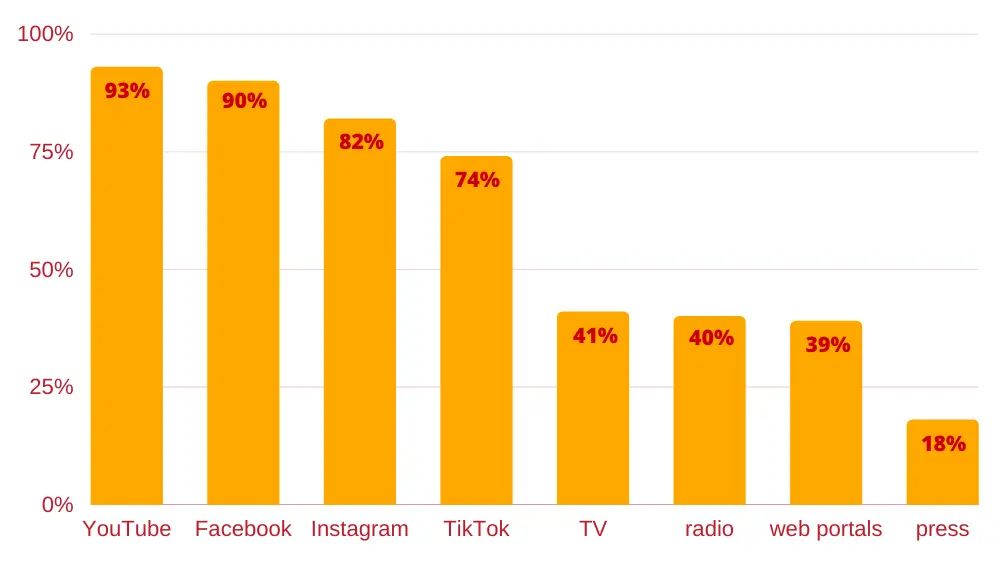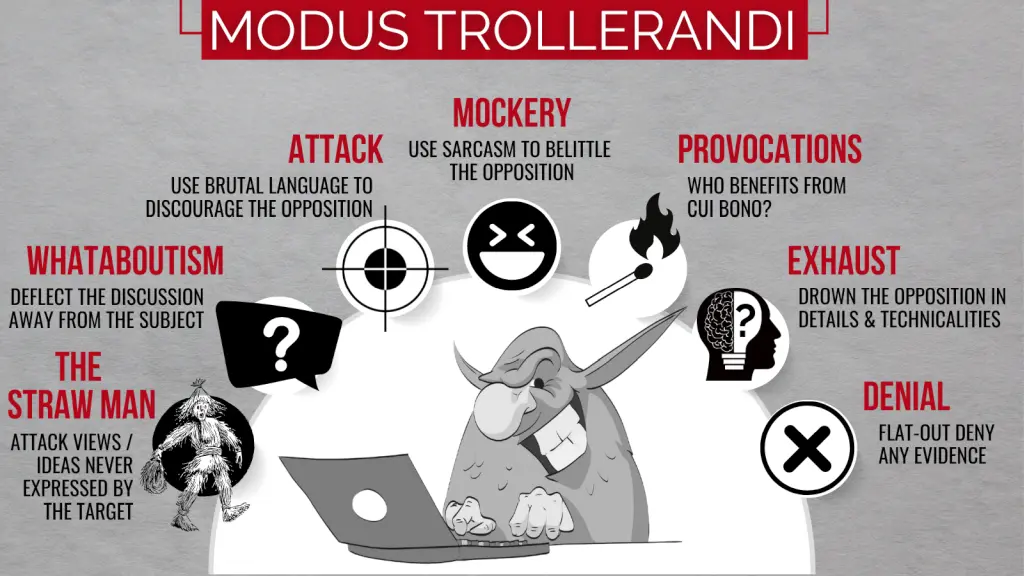Research published in February 2023 by Digital Poland illustrates how effective this channel is for spreading falsehoods:
- Fake news is 70% more likely to be shared.
- As a result, false information spreads six times faster than the truth.
The Most Effective Tool, the Most Resonant Topics
This is an overwhelming difference. The scale of the threat becomes even clearer when these figures are compared to the results of another study, conducted in November 2022 by Wise Rabbit for Clue PR. It examined the sources of information about global events for Poles aged 15-25:
Sources of Information on Global Events for Ages 15-25
 source: Wise Rabbit for Clue PR
source: Wise Rabbit for Clue PRFor older age groups, the proportion shifts slightly in favor of traditional media, but social media still accounts for a significant share in nearly every group. This translates to the next set of data, although these should be taken with a degree of caution. They may be underreported to an unknown extent.
These figures pertain to self-reported encounters with content identified as fake news. At least as perceived and recognized by the audience:
- 82% of people admit encountering it.
- 25% claim to see it several times a month.
- 20% encounter it weekly.
- 15% see it daily.
The data published by Digital Poland are declarative. It is impossible to determine how many false pieces of information bypass the audience`s defense mechanisms and take root in their unconscious. However, we do know the thematic areas from which debunked fake news originates. The most popular topics in recent months are:
- 52% - climate and energy
- 44% - health
- 20% - politics
Anti-Ukrainian Propaganda
The last topic has gained infamous popularity over the past months. It is tied to the war in Ukraine and the refugee crisis caused by Russian aggression. This aspect is regularly examined by the Institute of Media Monitoring and the fact-checking portal Demagog. Recent data from April 2023 reveal the following:
- Polish social media see approximately 60,000 anti-Ukrainian propaganda posts monthly.
- This averages to 80 posts per hour.
- In April 2023, NASK analysts identified about 1,600 accounts responsible for spreading false information.
According to the NASK report, many of these accounts previously flooded the internet with false information about vaccines and the COVID-19 pandemic. Traces often lead beyond Poland`s eastern border.
This thread is closely followed and reported by Debunk.org. Their latest findings from May 2023 reveal:
- In 2022, the Russian Federation allocated 143 billion rubles to propaganda media.
- This amounts to 1.9 billion US dollars.
- The original budget was exceeded by 25%.
SWAMPED. Russian Disinformation Techniques
The EU’s East StratCom Task Force, which identifies disinformation from outside the EU, has outlined the methods used by the Kremlin to spread disinformation globally, including in Poland. These techniques are summarized under the acronym SWAMPED:
 source: EUvsDisinfo
source: EUvsDisinfo- S for Strawmen:
Attack views or ideas, never expressed by the target.. - W for Whataboutism:
Deflecting accusations by changing the subject: "Why aren`t you addressing...?" - A for Attack:
Using harsh language to discourage opponents. - M for Mockery::
Using sarcasm to belittle opponents. - P for Provocations:
Making provocative, baseless claims. - E for Exhaust:
Overwhelming opponents with details and technicalities. - D for Denial:
Flatly deny any evidence.
These techniques share a common trait: they exclude any possibility of dialogue. More about these disinformation techniques can be read at https://euvsdisinfo.eu/modus-trollerandi-part-5-provocations/
60% of digital creators do not verify information before publishing 👇
How to Defend?
The most common advice for defending against fake news boils down to limited trust, verification, and fact-checking. Confirming the credibility of sources, authors, images, and videos. Following trusted media and visiting fact-checking platforms to verify critical information in the public space.
However, two additional problems arise. First, as consumers, we are not particularly interested in verifying doubtful information. Eurostat data from 2021 highlight this clearly:
 source: Eurostat
source: EurostatOnly one in four EU residents claims to have verified the truthfulness of information found on social media or elsewhere on the internet. In Poland, this percentage is far below the EU average - just 16%.
Trust Lost?
In Poland, there is an additional challenge: a crisis of trust in traditional media. These media should help verify the truthfulness of information but are increasingly seen as sources of fake news themselves. This is often due to political bias or insufficient research, which sometimes makes them victims of fake news.
As a result, Poles` trust in traditional media is at an all-time low. According to the Reuters Institute for the Study of Journalism, nearly 60% of Poles distrust traditional media as a source of information.
Trust in Traditional Media in Poland
 source: Reuters Institute for the Study of Journalism
source: Reuters Institute for the Study of JournalismIs there still hope to win the battle against disinformation? There’s no clear answer. We are at a point where we can only report: Houston, we have a problem! And we’re not even sure if Houston can be trusted - or who they even are....
* * *
* * *
This article is based on materials prepared for the conference MEDIA STUDIES AND PERSPECTIVES 4: Media and Journalism of the Future by the Institute of Journalism and Social Communication at the University of Wrocław. Thanks to the Polish branch of European Journalism Observatory for the invitation to the panel "EUROPEAN MEDIA LANDSCAPE AFTER THE TWO CRISES."
COMMERCIAL BREAK
New articles in section Media industry
Journalism in the age of AI. Why people prefer humans over machines
Krzysztof Fiedorek
Only 12% of people accept news created solely by AI, while 62% prefer those written by humans. At the same time, only 19% notice labels indicating the use of artificial intelligence, while younger audiences ask AI to explain the content to them. These are the findings of the Reuters Institute report on artificial intelligence in media.
Why do we believe fakes? Science reveals the psychology of virals
KFi
Why do emotions grab more attention than evidence, and why can a fake authority overshadow scientific data? Researchers from Warsaw University of Technology, Jagiellonian University, and SWPS University in Poland sought the answers. Here are their findings.
Investigative journalism in Europe. Newsrooms face pressure
KFi, Newseria
Media and political representatives point to the difficult situation of investigative journalism in Europe. Newsrooms are reluctant to invest in this segment due to high costs and the large amount of time and effort required. Most of all, however, they fear legal proceedings.
See articles on a similar topic:
Journalism and Technology. How Indian Newspapers Fight to Survive
KFi
The COVID-19 pandemic accelerated the transformation of India's press industry. Traditional print media, forced to fight for survival, adopted modern technologies ranging from data analysis to artificial intelligence. How do journalists adapt to new roles, and how do media redefine their future in the digital age? Researchers from the Symbiosis Institute of Media & Communication have explored these questions.
YouTube redefines viewer engagement. Goodbye to returning viewers
KFi
As many as 30% of internet users now turn to YouTube as their main news source, and 65% consume news in video form. Now the platform is shaking things up. Reach still matters, but engagement is what really counts.
Radio Listenership in Poland 2024: Demographics, Trends, and Statistics
Krzysztof Fiedorek
Why do millions of Poles still choose radio? What drives RMF FM's dominance and Eska's surprising results? The latest "Audio Track" report from the National Media Institute reveals listenership data, demographics, and evolving trends. How does the digital revolution affect traditional stations?
Can a Robot Be Good Boss? Researchers from SWPS Look for Answers
SWPS
A robot giving orders at work is no longer a science fiction scenario - it's a research topic. Scientists from SWPS University in Poland set out to find out whether a robot can effectively manage human workers.





























